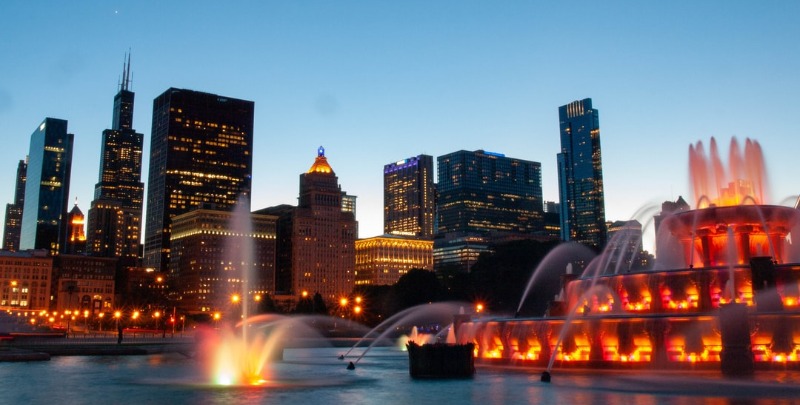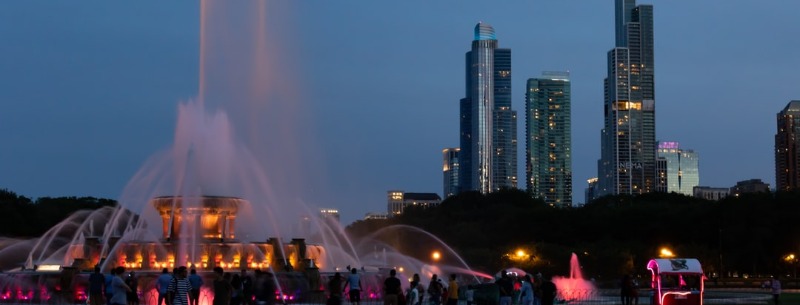If you are visiting Chicago for any significant period of time, more than likely you will see Grant Park. Nicknamed “The City’s Front Yard”, Grant Park is Chicago’s most famous park. This 319-acre park contains Millennium Park, Buckingham Fountain, and the Museum Campus (home to museums like the Art Museum, Field Museum, and Shedd Aquarium). The park was called Lake Park in 1844 when it was designated as “public ground forever to remain vacant of buildings”. In 1901 it was renamed Grant Park in honor of Ulysses S. Grant.
Grant Park is the site of many of Chicago’s most famous festivals, such as Lollapalooza and Taste of Chicago. The park hosts free music and cinema events in the summer, free ice-skating in winter, and was the site of President Barack Obama’s election night rally and acceptance speech on November 4, 2008.
Millennium Park
In 2004, a section of the park that was occupied by the rail yards was revamped and made into Millennium Park. The 24.5 acre sub-section of Grant Park is home to some of Grant Park’s most famous attractions, like the Cloud Gate sculpture (the Bean), Crown Fountain, The Jay Pritzker Pavilion and the Lurie Gardens. It contains the world’s largest rooftop garden and is connected to Grant Park by the Frank Gehry designed BP Pedestrian Bridge.
Museums in Grant Park
Grant Park’s most notable features are the Art Institute of Chicago, Buckingham Fountain, and the Museum Campus—a 10-acre (40,469 m2) addition to the southern end, which includes the Adler Planetarium, the Field Museum, and Shedd Aquarium. The park also features several walking and biking trails, a dozen tennis courts, and 16 softball fields. Programs include yoga, aerobics, and ice skating. The Daley Bicentennial Plaza at the north end of the park offers free locker rooms. Reservations for courts and fields should be made in advance (312-742-7650).
Grant Park: 312-742-7648
Even before the Chicago Fire of 1871, civic leaders realized that the city’s lakefront was something that should be protected to be enjoyed by all Chicagoans.
Chicago’s Grant Park (map) lies between the downtown business “loop” and The Magnificent Mile (Michigan Ave.) and Lake Michigan. It covers 319 acres and hosts three exceptional museums: the Shedd Aquarium, the Art Institute, and the Field Museum of Natural History, along with many of Chicago’s favorite icons.
Much of the park is actually landfill from the Chicago Fire and the city’s first underground subway system. An old tunnel system was built to hold underground telephone cables but after construction was completed, the owners secretly installed 24-inch gauge railroad tracks and used the tunnels to deliver goods and mail until the 1950s. You may recall the 1992 Chicago River tunnel flood. Same tunnels.
At the center of the park is Buckingham Fountain, one of the world’s largest fountains, was built in 1927. If you have the opportunity, don’t miss the dazzling light and water show nightly during the summer from 9-10 PM. (Free)

Croatian-born (then Austria-Hungary) sculptor Ivan Mestrovic’s sculpted a pair of horse-mounted Indian warriors, known as “The Spearman” and “The Bowman” (the latter scene in the photo above). They are located at the main entrance of Grant Park at Congress Plaza (Congress Dr. between S. Michigan Ave. and Columbus Dr.) At 17 feet high, the statues were erected in 1928. Mestrovic is widely recognized as one of the world’s most renowned post-Renaissance religious sculptors.
Pritzker Pavilion
The Pritzker Pavilion replaced the old Petrillo Band Shell when Millennium Park within Grant Park was opened in 2004. It’s host to all types of music and festivals including the Grant Park Music Festival – the only remaining free outdoor classical music fest in the U.S. The Pavilion seats 4000, plus has room for 7,000 on the lawn. Although the festival runs much of the summer, other concerts and performances including ballet, dance, jazz, and other types of music and performances happen almost nightly.
Cloud Gate
Cloud Gate or “The Bean” as it’s affectionately known (or not so affectionately) to locals, is a steel sculpture that’s been highly polished so that it has an almost mirror quality to it. Take your self-portrait in its reflection and try to find a seam”¦ impossible!!!
Crown Fountain
Crown Fountain is another recent addition. Incorporating two 50-foot LCD panels behind glass; the two main towers project images of over 1,000 faces of Chicagoans while integrating a water show. Walk the porcelain fountain and see if you feel like you are walking on water.
There are numerous other statutes, parks-within-parks, statues, flower gardens, and wonderful views of Chicago, but best of all, Grant Park is one of Chicago’s best places to just sit and watch the world go by.
History
The city officially designated the land as a park in 1844, when it was named Lake Park. It was renamed Grant Park in 1901, in honor of U.S. President Ulysses S Grant, a resident of Galena, IL. While the park had been deemed as “public ground forever to remain vacant of buildings”, several structures were planned for the area throughout the 19th century. Chicago businessman Aaron Montgomery Ward passionately fought on the people’s behalf for 20 years, wanting to keep the park natural and undeveloped. The only exception he granted was for the Art Institute of Chicago, built in 1892.
The park has been the site of several historical events, including clashes between the Chicago Police and protestors during the 1968 Democratic National Convention. It also hosted the championship celebrations for the Chicago Bulls and the 1979 visit of Pope John Paul II. Nowadays, Grant Park is the site of several of Chicago’s biggest festivals, including the Chicago Outdoor Film Festival, Lollapalooza, Taste of Chicago, the Chicago Jazz Festival, the Chicago Blues Festival, Venetian Night, and more.
Getting there
Grant Park is bordered by Randolph and Roosevelt to the north and south and by Michigan Avenue and Lake Shore Drive to the east and west. There is a parking garage underneath the park that can accommodate nearly 2200 cars. The Red and Blue EL lines stop at Jackson and State, just a few blocks from the south entrance while the Brown and Purple lines stop at Harrison and State to the south or Wabash and Randolph to the north. The Roosevelt, Randolph and Van Buren Metra stations provide access from outside Chicago, and buses run continuously up and down Michigan Avenue.
- Admission: There is no fee to enter the Park.
- Hours: The Park is open 365 days a year but if is off-limits between the hours of 11 pm and 6 am.
